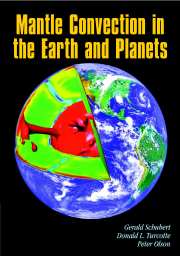Book contents
- Frontmatter
- Contents
- Preface
- 1 Historical Background
- 2 Plate Tectonics
- 3 Structure and Composition of the Mantle
- 4 Mantle Temperatures and Thermodynamic Properties
- 5 Viscosity of the Mantle
- 6 Basic Equations
- 7 Linear Stability
- 8 Approximate Solutions
- 9 Calculations of Convection in Two Dimensions
- 10 Numerical Models of Three-dimensional Convection
- 11 Hot Spots and Mantle Plumes
- 12 Chemical Geodynamics
- 13 Thermal History of the Earth
- 14 Convection in the Interiors of Solid Planets and Moons
- 15 Nature of Convection in the Mantle
- References
- Appendix: Table of Variables
- Author Index
- Subject Index
1 - Historical Background
Published online by Cambridge University Press: 15 December 2009
- Frontmatter
- Contents
- Preface
- 1 Historical Background
- 2 Plate Tectonics
- 3 Structure and Composition of the Mantle
- 4 Mantle Temperatures and Thermodynamic Properties
- 5 Viscosity of the Mantle
- 6 Basic Equations
- 7 Linear Stability
- 8 Approximate Solutions
- 9 Calculations of Convection in Two Dimensions
- 10 Numerical Models of Three-dimensional Convection
- 11 Hot Spots and Mantle Plumes
- 12 Chemical Geodynamics
- 13 Thermal History of the Earth
- 14 Convection in the Interiors of Solid Planets and Moons
- 15 Nature of Convection in the Mantle
- References
- Appendix: Table of Variables
- Author Index
- Subject Index
Summary
Introduction
The origin of mountain ranges, volcanoes, earthquakes, the ocean basins, the continents, and the very nature of the Earth's interior are questions as old as science itself. In the development of modern science, virtually every famous Natural Philosopher has conjectured on the state of the deep interior and its relationship to the Earth's surface. And every one of these thinkers has come to essentially the same general conclusion: despite the obvious solidity of the Earth beneath our feet, the interior must have flowed, in order to create the complex surface geology we see today. Although we can trace this idea as far back as written scientific record permits, it nevertheless remained a strictly qualitative hypothesis until the early part of the twentieth century. Then several timely developments in physics, fluid mechanics, geophysics, and geology finally established a true physical paradigm for the Earth's interior, mantle convection.
In reviewing the development of the concept of mantle convection, we find it is impossible to identify one particular time or event, or one particular individual, as being decisive in either its construction or its acceptance. Instead, the subject's progress has followed a meandering course, assisted along by the contributions of many. Still, there are a few scientific pioneers whose insights were crucial at certain times. These insights deserve special recognition and, when put together, provide some historical context with which future progress can be measured.
The idea of flow in the Earth's interior was popular among the early Natural Philosophers, as it was commonly assumed that only the outermost portion of the Earth was solid.
- Type
- Chapter
- Information
- Mantle Convection in the Earth and Planets , pp. 1 - 15Publisher: Cambridge University PressPrint publication year: 2001
- 2
- Cited by



